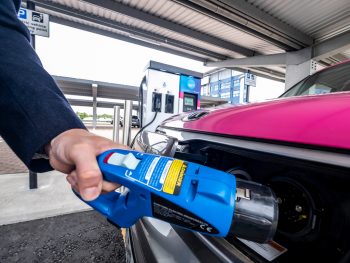Plans to introduce fees for Scotland’s EV charging network
Scotland’s charging network needs to evolve through much greater private sector investment and the introduction of fees for using charge points.

The report says the charging network needs to evolve to help drivers and businesses confidently switch to electric vehicles
That’s the finding of a new report from Transport Scotland and the Scottish Futures Trust that says both the scale and pace of investment in public electric vehicle charging infrastructure will need to be accelerated to meet growing demand over the coming years.
Take-up of electric vehicles will increase significantly in Scotland over the next decade in response to government policies and market responses.
The Scottish Parliament is planning to phase out the need for new petrol and diesel cars by 2030 to meet the climate change targets. The country has set a world-leading net zero target of 2045 and a legally binding target of a 75% reduction in greenhouse gas emissions by 2030.
And the report says the charging network needs to evolve accordingly to help drivers and businesses confidently switch to electric vehicles.
Data from Zap Map shows that, as of 28 June 2021, there were 2,558 public electric vehicle charging points in Scotland, representing 10.4% of the UK total. ChargePlace Scotland accounts for more than 1,800 of these and is by far the largest public network in Scotland and ranks fourth in the UK overall.
The report also notes that while the ChargePlace Scotland network of free-to-use public charge points was an important driver of early uptake, more sustainable financing models are required to remove barriers to private sector investment. ChargePlace Scotland chargepoints supported over 780,000 charging sessions in 2020 and in the process delivered over 10.47 million kWh of electricity in 2020, much of it free. Even where tariffs are introduced, simply covering the cost of electricity will not generate the funding required for asset management and replacement.
Instead, the report says there is an opportunity to bring together an even broader cross-section of the public sector – covering government, local authorities and regulators – as well as the private sector – from car manufacturers and charging providers through to electricity network owners and suppliers – to harness efficiencies and opportunities, and add value to the economy.
This includes the need for charge point hosts to review current pricing policies and electric vehicle charging tariffs to reduce public subsidy and, more importantly, increase commercial viability of new charging investment.
But the report also recognises the need to maintain a consumer-focused approach that provides equity of access to all users as part of the just transition to net zero.
Minister for Transport Graeme Dey said: “This report is clear that we are now at a tipping point in terms of current demand and future requirements. By retaining the best characteristics that Scotland enjoys through ChargePlace Scotland, the opportunities from inviting greater private sector involvement could be tremendous.
“To meet our world-leading climate targets, of course we need to see less car use rather than more. For those who need to drive, the opportunities afforded by electric vehicles for our climate and our air quality are profound. If the car is the right tool for transport on some occasions then we need people to have confidence to choose electric. This requires a comprehensive charging network and I’m pleased that this report provides a route map that supports our vision of phasing out the need for new petrol and diesel cars and vans by 2030.”
To access the report, click here.












